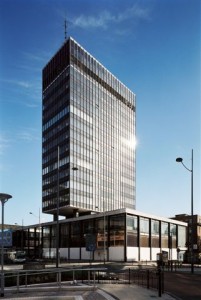The Master Planner’s plans are oft foiled by circumstances beyond their control. Birmingham has suffered as a result.
By Alan Clawley.
Although they belong to different generations, John Madin and Glenn Howells have a lot in common. They are both successful architect-planners. Madin did most of his work in Birmingham and the West Midlands between the mid 50s and the mid 70s. Howells celebrated twenty years in practice in 2010 spanning the 90s and noughties and has designed buildings all over the country.
Both architects were invited to draw up a master plan for the same Birmingham site – Paradise Circus. Madin’s plan for a Civic Centre was commissioned by the City Council in 1965. Howells’ plan for the demolition of everything on the site and its comprehensive redevelopment for commercial clients was commissioned by the property developer Argent in 2010.
Madin’s Civic Centre plan was killed off by the oil price crisis of 1974 and the subsequent cutbacks in public expenditure. Only the Central Library and the Conservatoire were built. The council’s dreams of a sports institute and various water features were strangled at birth.
Howells’ master plan is still on the drawing board and could suffer a worse fate than Madin’s if the property price crash that started in 2008 persists for much longer.
What has changed in the intervening years and how did the city fathers come to believe that Madin’s plan was so bad that an entirely new one needed to be done? Why did they not complete the approved plan when the economy recovered in the 90s?
There can be no question in my mind about the respective merits of the two architect-planners involved. Both are architects of the highest standing in their profession. Madin’s firm won three RIBA medals and Howells was shortlisted for the RIBA Stirling prize in 2007. There is nothing to choose on quality between Madin’s Birmingham Post and Mail and Howells’ Eleven Brindleyplace, so no-one can claim on this evidence that one is so superior to the other and will produce a better master plan simply on those grounds. Howells’ advantage is that he is young and in touch with the latest fashions.
There are two explanations for what has befallen Paradise Circus, each of which is impossible to disentangle from the other. One is ‘Fashion’ and the other ‘Economics’.
Madin’s plan followed the fashion set by Professor Colin Buchanan in his report ‘Traffic in Cities’ (1965). Buchanan’s solution to the worsening conflict between pedestrians and vehicles was to build on platforms over the streets on which people could walk in safety above the cars buses and trucks that served the city. Buchanan realised it was impossible to demolish and rebuild entire cities along these lines, especially historic ones like Norwich, but Birmingham, or Car City, thought they could do it in Paradise Circus for a start and perhaps extend it beyond Paradise Circus by high level pedestrian bridges. In fact only the bridge to the Council House was built. The design of the Central Library included a bus station underneath it like those in Worcester or Redditch today, but for some unknown reason it never happened.
Today what highway engineers call ‘grade separation’ is unfashionable in cities. Pedestrian subways are being filled in and the flyover at Masshouse Circus has been demolished. Planners now talk of boulevards where pedestrians and slow-moving traffic can intermingle. But just as Buchanan warned that entire cities could not be swept away and rebuilt to suit the latest fashion so today we can only change them in a piecemeal way. Paradise Circus seems to have become a test-bed for such change.
Howells’ master plan may look more up-to-date than Madin’s, but the chances of it being implemented in its entirety are no more likely.
History shows that all master plans are affected by economic downturns and failed ones are only remembered as the over-ambitious and unrealistic dreams of the people who commissioned them.
Unless the master-planner and his client are in full control of economic events, and this is rarely the case, the plan must be able to adapt to unforeseen circumstances. And even if it is possible to create such a plan, what will it look like?




